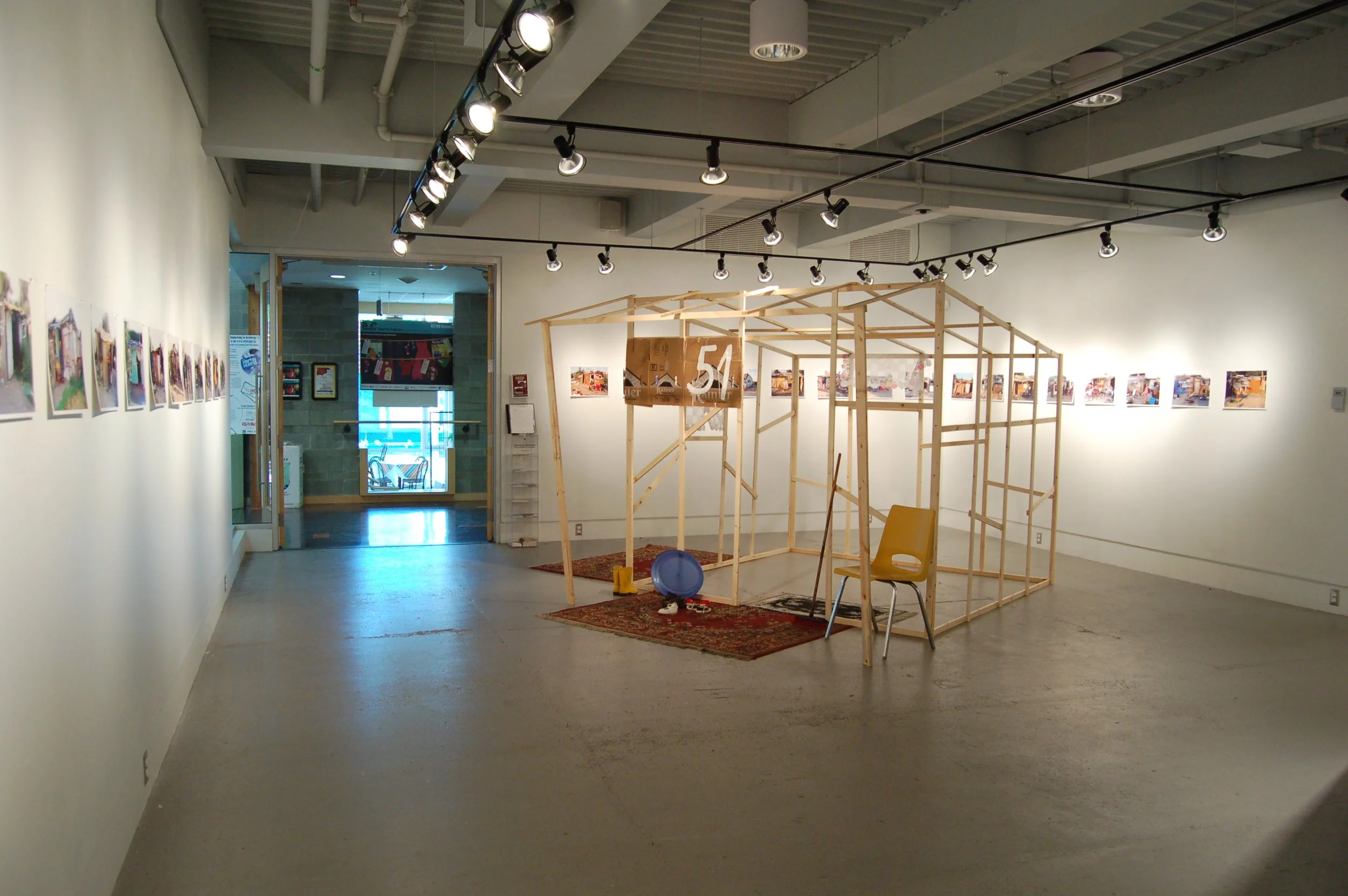Parallel World: The Architecture of Survival was a sculptural and media installation incorporating photographs of temporary shelters in downtown Belgrade built by refugees from Kosovo and other migrants seeking a better life. Artists Boja Vasic & Vessna Perunovich constructed a shanty house in the gallery together with a two-channel video titled Gypsy Utopia. Their work considers the social, political and economic realities that force people into a nomadic existence. In this installation, architecture worked as a powerful visual and environmental force, making it impossible for viewers to ignore ostracized members of society.
Boja Vasic is a Toronto based media artist and photographer. His work has been shown at the 8th Havana Biennial in Cuba, VI Yugoslav Biennial of Youth Vrsac in Serbia, XIII International Art Biennial of Vila Nova de Cerveira in Portugal, Third Tirana Biennial in Albania, and at the Liverpool Biennial, Independents. His video were shown at festivals in Copenhagen, Amsterdam, Chicago, Denver, Toronto, and he has won several international awards including the Chris Award at the Columbus International Film and Video Festival, a Bronze Medal at New York Festivals, and the Gold Award at Dallas HeSCA Media Festival.
Vessna Perunovich is a Toronto-based internationally acclaimed interdisciplinary artist whose work embraces performance, video, sculpture, painting and drawing. She works with issues around home, displacement the notions of mobility and boundaries. Perunovich’s work constantly brings to forefront her own position on the borders of identity in its multiple formations (social, political, personal, cultural and so on). Born and educated in Former Yugoslavia, Perunovich moved to Toronto Canada in the late 1980s. Her artistic practice reflects the multifaceted nature of her diasporic experience; it is interdisciplinary, performative, and often transitory in form and content. The artist’s body and her personal experiences are always the point of reference for an aesthetics that operates intuitively, and practice that challenges one’s capability to move beyond barriers imposed by spaces, institutions, ideologies, or body’s own limitations.
The Roma (in) Ruins // Interpretive Essay by Vessna Krstich and Nikolas Drosos
The industrious gypsy peddler was a common figure in the city of Belgrade during the civil war years in the former Yugoslavia. Today, the Serbian capital is striving to recover from international isolation by promoting capitalist enterprise and urban regeneration, often at the expense of the Roma population. While organizations exist to prevent further exclusion, discrimination restricts their participation in the educational system and labour market. On the other hand, their own socioeconomic conditions as well as their ill-reputed status, further segregates this ethnic group from mainstream society.
Toronto-based documentary filmmaker Boja Vasic and artist Vessna Perunovich have returned to their homeland to document this marginalized community. The pair revisited their former neighbourhood in Novi Beograd (New Belgrade) and the gypsy settlement nearby, which they approached with a new sensitivity, after having spent twenty years living in Canada. Themes of displacement and exile are reoccurring leitmotifs in Perunovich’s oeuvre while political and anthropological issues shape Vasic’s cinematic work. Parrel World: The Architecture of Survival, represents their combined efforts to explore the economic, social and political dimensions of architecture and the idea of forced nomadism.
99 photographs of Roma gypsies in front of their homes don the gallery walls. Each shack is marked for demolition and the blurred backgrounds efface the high rise apartment buildings in the distance. The artists have also installed a replica of one of these shanty dwellings, which they assembled from discarded materials. By reorganizing waste into living quarters the Roma gypsies perform an act of ‘recycling’. The resulting ’organic’ edifices are perishable, forced to extinction much like its inhabitants. This type of architecture could be seen as the other ‘international style’ of the late modern era. Made from found materials, mostly wash of the big urban centres, these ephemeral structures can be found today in most parts of the world, from South America to Europe and Southeast Asia. They represent a parallel yet antithetical world to the structures typical of global capitalism: the ephemeral shantytowns versus the permanent glitzy high-rises, the architecture of survival versus the architecture of profit.
The distance between these two parallel worlds is also reflected in the two-channel video projection. Hidden from view in order to remain inconspicuous, the video camera slowly pans the desolate dump of this Roma encampment. It only surveys the sit and does not scan for more intimate details. While this trepidation creates an objective vista on the part of the artist/researcher it also makes us more self-conscious of our status as a privileged intruder.
Vesna Krstich is a Toronto-based educator, art critic and independent curator. Her research explores the interrelationship between art and experimental pedagogic practices from the 1960s onwards. She received her MA from the Courtauld Institute of Art, where she specialized in Contemporary Art. Krstich’s writing has appeared in Art Papers, Parachute, C Magazine, Canadian Art, and Curator: The Museum Journal, among others.
Nikolas Drosos is a postdoctoral fellow at the Getty Research Institute, Los Angeles. He specializes in Modern Art, with an emphasis on Eastern European Art in its global context. He holds a PhD from the City University of New York and a MA from the Courtauld Institute of Art, University of London.


